
Monuments are best-known landmarks
WASHINGTON, D.C.— This city, with its series of circular roads, might have been, for the international tourist, or American on his pilgrimage to the nation’s capitol, difficult to navigate were it not for the Washington Monument.
The white marble, obelisk beacon in the center of the National Mall between the Capitol Building and the Lincoln Memorial guides many lost or disoriented tourists through the city directing them in the direction of the many landmarks within the center.
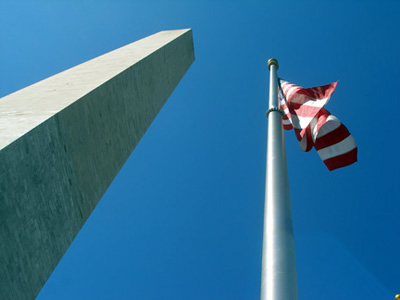 |
A flag waves in the early spring breeze alongside the Washington Monument. The monument is encircled by 50 American flags; one for each state (Photo by Melinda Masdeu). |
More than just a 3-D “you are here” point for the confused tourists, the Washington Monument has become synonymous with the District of Columbia itself.
Unlike some of the other big memorials in its proximity, such as the Lincoln and Jefferson memorials, the Washington Monument seems to be almost a tribute to itself rather than a tribute George Washington.
George Washington, who first led ill-equipped and heavily outnumbered armed forces through the rugged terrain of an undeveloped country in an effort to end tyrannical rule, and later, as president, set precedence for all future leaders of what would become the most influential nation-state in all the world, would seemingly be deserving of a monument honoring his life within this nation’s capitol.
After all, the district houses memorials to Thomas Jefferson, and Abraham Lincoln, two men equally influential in our nation’s brief yet immense history. The Lincoln Memorial is arguably a shrine to Abraham Lincoln, said Park Ranger Lowell Fry in his 5 p.m. tour of the memorial.
The sheer size of Lincoln’s likeness in the memorial, 19 feet from base to top, gives an impression of Lincoln’s greatness. The Gettysburg and second inaugural addresses, written by Lincoln himself, as Fry points out in his tours, are inscribed in the walls, where people of all ages stand reading.
Similar can be said of the Jefferson Memorial. It is an obvious tribute to one of the most influential philosophers involved in the birth of our nation. Quotations from Jefferson adorn the walls of the memorial and the influence of Jefferson on so many different aspects of society is abundantly apparent to the people who have visited.
Jefferson, while less known internationally, and having fallen under some controversy over his involvement in slavery here at home, still demands a certain level of awe from people visiting the memorial.
The Washington Monument, in stark contrast, does not have a larger than life sculpture of Washington himself within its walls. Instead, on the lower level, behind the elevator is a small replica of the famous Houdin statue made from a life mask of Washington’s face. The statue was added in the 1990s.
| People walk the length of the reflecting pool to the Lincoln Memorial. Many individuals visit the memorial to take in the view of the city (Photo by Melinda Masdeu). | 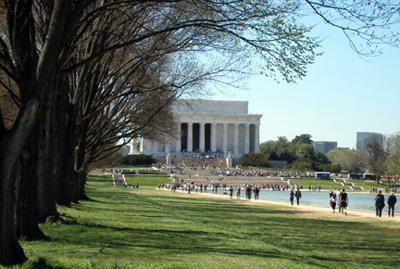 |
“We needed to represent Washington more strongly,” said Park Ranger Kristi Thiel.
On its exhibition deck, three walls are dedicated to a history of the monument itself, with only one wall left to describe the life of the first president of the United States.
Why is it that in Washington D.C., a city named for our first president, that there is so little about George Washington in the monument when Jefferson and Lincoln have shrines to their legacies?
The intention of the Washington Monument was “to build a monument to George Washington as great as the legacy of the man himself” said Thiel, who continued, “Of course the greatest monument [to Washington] is the city of D.C. itself.”
Well intentioned, and great though it may be, is the Washington Monument really a monument to the legacy of George Washington? Why is it that there is so little representation of Washington within the monument?
One possibility is that no other monument has such a long history itself, filled with as much conflict as the Washington Monument has. Maybe despite the best of intentions, the intense conflict over the monument itself and the incredible amount of time that it took to be completed made the monument itself notable in American history.
Unlike the Lincoln and Jefferson Memorials, which were planned, and completed in the 20th Century as public works projects, the Washington Monument was a mostly privately funded work in progress from pre-conception in 1783 until the dedication in 1885.
The Washington Monument, which was first conceived prior Washington’s presidency as a tribute to the famed general, began construction on the current version on July 4, 1848.
Although Thiel made a particular point of saying that the Civil War was not the cause of any halt in construction of the monument, the effort to finish it did suffer during that time because funding stopped.
The Know Nothing Party, or the American Party, infiltrated the Washington Monument Society in an effort to prevent donations coming from minority groups. The conflict began specifically over a memorial stone donated by the Vatican, which the Know Nothings would steal. People stopped donating as a result of the takeover.
The monument would remain more or less a 150-foot stump for 25 years. Mark Twain described it as having “the aspect of a factory chimney with the top broken off.”
When it was finally finished in 1885, 102 years after it was decided that a monument to Washington would be built in the nation’s capitol, it was a great achievement that it was completed.
Having been privately funded by donations, memorial stones to President Washington were donated by all sorts of groups. These stones, which are visible from the inside of the monument, were from 1976 until the turn of the 21st century invisible to visitors to the monument.
This was because vandalism and health concerns caused the National Park Service to close off the stairway to the top, making the elevator the only means of getting to the top.
The renovations in 1998 made it possible to once again see these stones, many of which have sculpted renderings of Washington by slowing the elevator and making the glass transparent while going past certain floors.
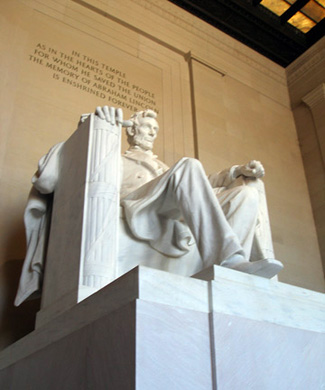 |
The statue of Abraham Lincoln in the Lincoln Memorial is 19 feet from base to head. The inscription above reads: “In this temple as in the hearts of the people, the memory of Abraham Lincoln is enshrined forever” (Photo by Melinda Masdeu). |
This seemed successful in bringing some of the focus back to Washington the man. However, the Washington Monument says far less about Washington than the Lincoln and Jefferson memorials say about them.
In the late 1990s, all three memorials underwent renovations, which redesigned, and, in the case of the Jefferson Memorial, added the exhibition levels that are currently in place.
In the Lincoln Memorial, after viewing the awe-inspiring sculpture, done by Daniel Chester French, a tourist or democratic pilgrim might wander over to the left side of the monument, possibly in search of the restroom, and stumble upon the lower level exhibition.
Upon entering, you can see inscriptions in marble of quotes both spoken and from letters exemplify Lincoln’s views on slavery, freedom and the union.
From the back, booming, slow speaking voice recites Lincoln’s more influential speeches on a video documentary, surrounded by photos of peaceful civil rights marches that convened at the Lincoln Memorial. People walk through the exhibition reading the excerpts and commenting to friends on how these quotes relate to stories they’ve heard about Lincoln.
Many of the quotations seem to assert that while Lincoln believed that slavery was fundamentally wrong, it was not the reason for the Civil War, that Lincoln would have neglected to address the issue of slavery if he could have while preserving the union.
Inscribed in stone, to represent Lincoln’s views on the Union, a segment from a letter to Horace Greely from Lincoln said:
“If I could save the Union without freeing any slave I would do it, and if I could save it by freeing all the slaves I would do it; and if I could save it by freeing some and leaving others alone I would also do that.”
Fry disagrees.
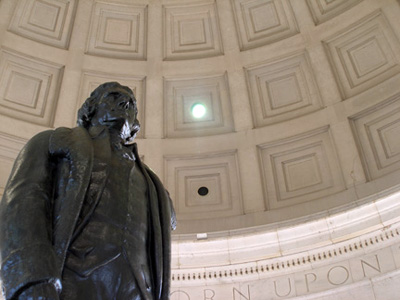 |
The statue of Thomas Jefferson stands alone in the center of the rotunda, surrounded by inscriptions of quotations from notable speeches (Photo by Melinda Masdeu). |
“Slavery was the cause of the war,” said Fry making this argument despite a tendency for people to cite state’s rights and economic reasons for the cause of the Civil War.
“Even if it was state’s rights, a lot of it would be state’s rights to have slaves, but you don’t see that here, “ said Fry of the Lincoln memorial.
In fact in Fry’s opinion the only place where slavery is reflected in the memorial excluding the exhibition level is in the allegory of the murals above the Gettysburg Address, which Fry points out, deals indirectly with slavery.
In the mural, the Angel of Truth’s hands are raised in order to show emancipation.
Fry suggested that the reason for the under-acknowledgment of Lincoln’s views on slavery in the Lincoln Memorial is because of the controversy over civil rights for African American’s over one hundred years after emancipation.
At the dedication of the Memorial in 1922, the audience was segregated and African American speakers were made to speak from the steps below, rather than above where white speakers stood.
“The chief speaker Robert Motin, president of Tuskegee, had his doctorate, and he could not stay up here, because he was black.” Fry said gesturing toward the statue beside him,
While slavery may be under represented in the Lincoln Memorial, there is no question of its prominence in the newly renovated exhibition level of the Jefferson Memorial.
It is no secret that Jefferson owned slaves, and it has been a hot topic from time to time in the news lately because of controversy over the possibility and likelihood that Thomas Jefferson fathered the children of his slave, Sally Hemings.
Although, the memorial does not reflect this event within the exhibition level, there is definitely a strong focus on Jefferson’s views on slavery.
There is a specific section of the small exhibit dedicated solely to Jefferson’s philosophy on slavery.
| The Jefferson Memorial stands across the Tidal Basin from the National Mall (Photo by Melinda Masdeu). | 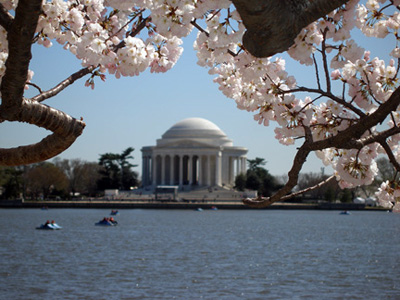 |
According to the exhibit, Jefferson was opposed morally to slavery, but this did not prevent him from owning slaves. Though the exhibit points out that while in Monticello, his Virginia home, he saw that his slaves were well treated.
The rest of the exhibit is a timeline of Jefferson’s life broken down by accomplishments and eras.
Regardless of the role of slavery in the Jefferson and Lincoln Memorials, there is no question when viewing them who the memorial is for.
The Washington Monument is known for other reasons.
Yong Zhang, 30, a resident of Rochester, N.Y., and originally from China, said that he wanted to see the Washington Monument because it was so famous.
“You can see it everywhere in D.C. It is the center,” said Zhang, who also commented “foreigners generally know Washington and Lincoln better than Jefferson.”
While the Washington Monument was a key element of Washington, D.C., Zhang noted that he went to the Lincoln Memorial because Lincoln was “the greatest man in United States History.”
Even to Americans the Lincoln Memorial has a particular draw that the others do not have because of Lincoln’s presence within it.
Barbara Cordes, 58, of Northville Minnesota, in her reason for liking the Lincoln Memorial best said of Lincoln, “I think he represents solidarity, and that’s what we need.”
For Washington residents, the Lincoln Memorial offers a place for thoughts.
Brian Cordes, 26, a resident of the District, said of the memorials, “I come to the Lincoln Memorial so I can sit on the steps and take them all in. It’s a good place to sit and think.”
If You Go
Washington Monument
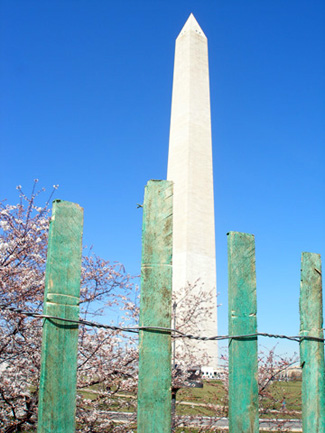
- Hours: 9 a.m. to 5 p.m. daily (except Dec. 25)
- Tickets are available free of charge the same day in the ticket booth at the base of the hill.
- Parking: Two-hour parking is available on Constitution Avenue.
- Prohibited items: Food and drink other than water from a clear plastic container, guns, ammunition, knives, aerosol cans or mace, baggage or packages larger than 18 inches by 16 inches by 8 inches, strollers and animals.
Lincoln and Jefferson Memorials
- Hours: 24 hours. Park rangers are only available 9:30 a.m. to 11:30 p.m.
- Parking: Limited free daylong parking is available on Ohio Drive.

Comments are Closed